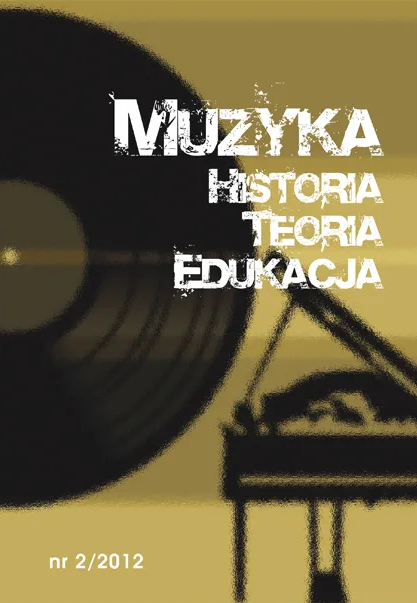Difference in aesthetics of sound in the violin sonatas by Bydgoszcz composers
DOI:
https://doi.org/10.34767/MHTE.2012.02.05Abstract
The article is an attempt at viewing the violin sonatas created by Bydgoszcz composers in the second half of the 20th century, from the point of view of aesthetics. It is an contributory article written on the basis of wider research, carried out for a few years, on Polish violin sonata of the 20th century. Introductory deliberations pertain to the concept of aesthetics with reference to sound as an aesthetic value. It is followed by the main part of the article: a review of sonatas by three composers: Konrad Pałubicki, Ryszard Kwiatkowski and Marcin Kopczyński. Remarks pertaining to other works are preceded by characteristics of lifetime works of the composers. Two sonatas for violin and piano by Konrad Pałubicki (1910-1992), composed, respectively, in 1970 and 1983, according to the technique called structuralism. The technological commentary includes references to the literature on the subject (Zielinski, Helman) and Lutosławski’s harmonic system in order to explain categories of the interval class, and through this class, to explain the method of interval structuring applied by Pałubicki. After deliberations on the technique used by the composer, there are remarks concerning the aesthetic and sound side. It leads to the conclusion that the main sound value is the ploymorphic nature of sound movement and the resulting “hidden tone colour”. Apart from structural development, the 3 Sonatas for solo violin op. 15 from 1961 by Ryszard Kwiatkowski (1931-1993) introduce elements of sonorousness. In the works of this composer, the technique of structure transformations has a clear melodic nature and demonstrates connections with the evolutionary character of traditional shaping. The 3rd Sonata of the opus is an exception, which is qualified, owing to its sound language, as sonorous. Poetics of the solo sonatas makes a deep impression with the beauty of its sound effects and leans towards formalist aesthetics and towards experiencing short sound structures, the play of colours. deliberations on Kwiatkowski’s sonorousness are supplemented with quotations from the works by J. Chomiński and W. Szalonek. In the dodecaphonic Sonata for Violin and piano published in 1976, the same composer used segment form, in which the organizing factor is not only the serial technique, but rhythmical patterns as well. Analysis of the work is completed with remarks by Alicja Jastrzębska, the authoress of an extensive publication on serial technique in the 20th century music. In his two sonatas for violin and piano, Marcin Kopczyński (b. 1973), a young generation composer from Bydgoszcz refers to rhythmical movement and its energetic and movement lanes. They represent stylistic syntheses belonging to the postmodernist stream and, at the same time, they are expressions of individual search in the field of sound language (triton-fourth chords). The 2nd Sonata of this composer is a tribute to Bela Bartok, whose certain traits of style are used in it. In both sonatas by Kopczyński the aesthetics of sound is e bit different: in the 1st Sonata it is aesthetics of kinetic expression, in the 2nd Sonata, the sound side is constituted mainly by harmony. deliberations on the aesthetic dimension are extended here with remarks made in the early 50s by a psychologist and pedagogue, Stefan Szuman. Dissimilarity of attitudes in the aesthetics of sound of the discussed composers confirms the abundance and variety of trends in Polish music of the 20th century.
References
Baculewski Krzysztof, Polska twórczość kompozytorska 1945-1984, PWM, Kraków 1987.
Chomiński Józef Michał, Historia harmonii i kontrapunktu, t. III, PWM, Kraków 1990.
Chomiński Józef Michał, Muzyka Polski Ludowej, PWN, Warszawa 1968.
Fubini Enrico, Historia estetyki muzycznej, przeł. Zbigniew Skowron, Musica Iagellonica, Kraków 1997.
Gołaszewska Maria, Świadomość piękna, PWN, Warszawa 1970.
Gołaszewska Maria, Zarys estetyki, PWN, Warszawa 1984.
Helman Zofia, Strukturalizm interwałowy w technice kompozytorskiej XX wieku, „Muzyka” 1975.
Jarzębska Alicja, Idee relacji serialnych w muzyce XX wieku, Musica Iagellonica, Kraków 1995.
Kopaliński Władysław, hasło: ekspresja, [w:] Słownik wyrazów obcych i zwrotów obcojęzycznych z almanachem, Świat Książki, Warszawa 2000.
Lissa Zofia, hasło: Baumgarten Alexander Gottlieb, [w:] Elżbieta Dziębowska (red.), Encyklopedia muzyczna PWM, część biograficzna, t. 1, a b., PWM, Kraków 1979.
Lissa Zofia, Nowe szkice z estetyki muzycznej, PWM, Kraków 1975.
Maćkowiak-Koszykowska Małgorzata, Twórczość kameralna Konrada Pałubickiego. Analiza – próba syntezy, praca magisterska napisana pod kier. Ewy Synowiec na Wydziale Kompozycji i Teorii Muzyki, sekcja Teorii Muzyki PWSM w Gdańsku, Gdańsk 1980 (maszynopis).
Moll Lilianna, Witold Szalonek. Katalog tematyczny dzieł. Teksty o muzyce, Śląskie Towarzystwo Muzyczne, Akademia Muzyczna im. K. Szymanowskiego, Katowice 2002.
Podhajski Marek (red.), Kompozytorzy polscy 1918-2000, II: Biogramy, Akademia Muzyczna w Gdańsku, Akademia Muzyczna w Warszawie 2005.
Przech Violetta, Katalog tematyczny utworów Ryszarda Kwiatkowskiego, Akademia Muzyczna im. F. Nowowiejskiego, Bydgoszcz 2005.
Rae Charles Bodman, Muzyka Lutosławskiego, przeł. Stanisław Krupowicz, PWN, Warszawa 1996.
Strawiński Igor, Poetyka muzyczna, PWM, Kraków 1980.
Szuman Stefan, Ruch jako czynnik organizacji i wyrazu w utworach muzycznych, PWM, Kraków 1951.
Tomaszewski Mieczysław, Interpretacja integralna dzieła muzycznego. Rekonesans, Akademia Muzyczna, Kraków 2000.
Zieliński Tadeusz Andrzej, Problemy harmoniki nowoczesnej, PWM, Kraków 1983.

